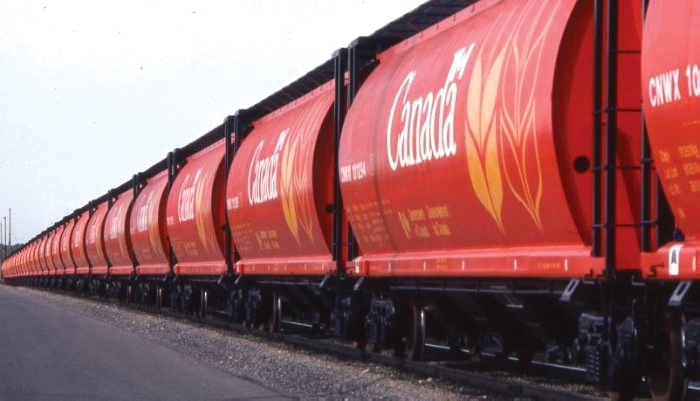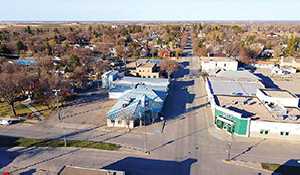Moosomin producer car siding targeted for closure
September 14, 2017, 5:05 am
Kevin Weedmark


The Agricultural Producers Association disagrees with the Canadian Pacific Railway’s decision to close at least 10 producer car loading sites in Saskatchewan, including one at Moosomin, and is asking for a federal moratorium.
In a letter to Federal Transport Minister Marc Garneau, APAS is requesting a moratorium on the closure of producer car loading sites until a full review of railway costs is completed.
The letter also requests legislative changes to ensure that the closure of urban and rural sidings are subject to the same requirements.
“Producer car loading is an important source of competition and innovation in Saskatchewan’s agriculture industry,” said APAS President Todd Lewis.
“Shipping grain by rail is far more cost-effective than hauling grain long distances by truck and results in a much smaller carbon footprint.”
Lewis also pointed out that once a loading site is listed for discontinuance, it is extremely difficult to have the site re-listed for service at a later date.
“Although demand for producer cars has declined in recent years, our industry is very dynamic,” Lewis said. “There is the potential that crop diversification and increased production could lead to more demand in the future. This demand will not be met if producers lose access to their local rail sidings.”
Grain producers have a legislative right to order rail cars through the Canadian Grain Commission under the Canada Grains Act.
This is to ensure that producers have meaningful access to market their grains using Canada’s rail network.
However, in the last decade, Canadian railways have been closing public loading sites at an accelerated rate.
If these closures proceed, the number of loading sites on CP rail lines in Saskatchewan will be reduced to 26, down from 79 in 2005.
Although the number of sidings have decreased dramatically over the years, the railways are currently compensated for maintaining the same number of sidings that existed in 1992.
“The Maximum Revenue Entitlement program’s formula is clearly out of date,” Lewis said.
“What we are saying to the Minister is no more closures until we get a costing review to bring it in line with today’s operating environment.”
Under the Canada Transportation Act, railways can close a loading site after 60 days of publicizing the notice in a local newspaper.
APAS is also asking that that time frame is extended to give municipalities and affected producers more notice and ensure they are adequately consulted.
If no moratorium is granted, the Moosomin siding could be discontinued by mid-September along with sindings at:
Tompkins – RM of Gull Lake
Midale – RM of Cymri
Cupar – RM of Cupar
Markinch – RM of Cupar
Grand Coulee – RM of Lumsden
Wilcox – RM of Bratt’s Lake
Tisdale – RM of Connaught/Tisdale
Qu’Appelle – RM of South Qu’Appelle
Duval – RM of Last Mountain Valley
Lewis said APAS found out about the closures after CP placed a notice in the World-Spectator to announce the Moosomin closure. Sinc Harrison read it and contacted APAS.
While federal legislation requires railways to notify the public in the case of a closure, there is no requirement for consultation once notice has been given.
Law requires notice but not consultation
“The one requirement they have is to advertise it and then they can go ahead and close it,” said Lewis. “That is part of the issue. If it were a metropolitan site it is a lot more rigorous to close a siding. You have to notify the minster of highways, you have to notify the local municipality, the transportation authority, it is a lot more of a rigorous process. Once notice is given you can’t close it for 12 months. But that is not required for a rural site. That is problematic in itself. CP has taken no consultation—they are just going to close these sites.”
Lewis said farmers will still be paying the cost of maintaining the sites through freight rates once they are closed.
“The really crazy part of the whole thing is that farmers won’t save a nickle because under the maximum revenue entitlement those sites are included in the calculation as all the sites since it was reviewed, which was 1992. All those sites are part of the MRE calculations, so farmers will continue paying for those sites until there is a costing review. We won’t have the service but will still be paying for the cost of the service even though it does not exist anymore.”
APAS calls for moratorium on closures
Lewis said he’s hoping the federal government will step in and stop any closures at this point.
“We have asked the minister to put a moratorium on any closures at this point.”
CN is not planning any closures. CP plans to close 10 sites in Saskatchewan, six in Alberta, and two in Manitoba—18 sites altogether.
According to CP, the closures will allow the railway to provide better service, but Lewis doesn’t buy that.
“CP is saying it is about service and everything else. Well that is part of the issue—the rail system has been so unpredictable. A perfect example—if you had ordered a producer car from CP there were lots of weeks last winter that you had a 50-60 per cent chance at best of receiving it.
“So if you would have ordered a car for Monday, the third week in January, and had all your trucking lined up, and all the grain in place and the car didn’t show up, what would you do? If you didn’t know when it was going to come, how could you order producer cars? The service has been so poor—it is very difficult to run a business that way. They need to get some of their ducks in a row as far as service. If you had reciprocal penalties—if you ordered a producer car and it wasn’t delivered and you were going to get paid for that lost time—that may make more of these sites more valuable as well.”
Lewis said APAS had not met with CP on the issue.
“We haven’t had time—this is right in the middle of harvest,” he said. “This happened in August. We are getting this information out now and we only have 60 days to talk about it.”
Lewis questions the timing of CP’s announcement.
“You sure wonder about the timing. Certainly with the changes in legislation—and the new legislation has not even been passed yet—I think the minster should wait to see how it affects pieces of the puzzle like producer cars.”
Lewis believes there is a future for producer cars as the marketing systems for agricultural products change.
“As the grain industry evolves, there are lots of smaller players that want to buy producers’ product and get it into export position,” he said. “Some of those players are looking directly at producer cars to ship their product to the coast.
“I think it is an opportunity that is probably going to grow, not lessen. If you close these sites there are other sites available, but they are farther away and would have more of an impact on municipal roads and highways, and be a higher cost to producers.”
The Moosomin siding was used to ship 60 producer cars in the 2014-2015 shipping season, and none in the 2015-2016 season.
“That is pretty significant, especially for those producers that used them,” said Lewis. “That could be the majority of their crops, depending on the size of the farm. 60 cars out of Moosomin is pretty significant.
“Producer cars are entrenched in legislation and should be made available. The producer car system provides good balance because if you have wide swings, crazy swings in basis, if the basis get too high you can order a producer car, which saves you quite a bit of money and makes it more worth your while.
“If there are other means of moving your crop through an elevator system or if a company is taking too much off the top and you think can do it better, you can load it yourself with the producer cars. It just adds balance. The availability is pretty important.
“There is not much sense to have it in legislation if you don’t have sidings to put cars through. Really the notion that these sidings are costing CP a bunch of money is ridiculous—they are getting paid for those sidings. We pay as producers. We pay for the upkeep of those sidings.”
No word back from federal government
APAS has not yet heard back from the federal government.
“It was just this week we put this out so we haven’t heard back,” said Lewis. “Sadly things don’t move that quickly.”
He said he is hopeful the federal government will listen to APAS’s concerns.
“We certainly expect a full hearing and certainly the concept of a moratorium at this point should be a fairly easy concept to grasp, because of the legislation changes that are coming. Just on the reciprocal penalties alone, the producer car may end up being a lot more viable option for producers if it is on the railroad and they make sure they get those cars delivered on time just the same as they do for any of the grain companies. The railway has to be held to task if they don’t fulfill their orders. That should help the producer car situation as well.”
Lewis thinks the federal government would be wise to issue a moratorium so the sidings aren’t closed before producers have a say and before new legislation comes into effect.
“I think it is the minister’s call,” he said. “It is a short time frame. The minister has to make a quick decision and that’s what we expect. A moratorium can be a set amount of time—it doesn’t have to be an open moratorium.
“With the new legislation not passed yet, perhaps their is opportunity to change some of the wording in the legislation to answer some of the questions with time lines and certainly the consultation process. Right now it is really not a consultation process it is just a notification process. CP, with the press release they put out, are saying that the sites are going to close at the end of September. There is no mention at all about consultation, just giving notice that they are closing. It is pretty important infrastructure. It is infrastructure that has been there for years and what is the harm in leaving it there until we get some of these things figured out?”
APAS is asking its members to lobby the government on the moratorium.
“We have asked our member RMs to help. We have sent out a template to our membership, hoping that those councils will send a letter to Minister Garneau.”
Low usage doesn’t mean producer car sidings not needed
Sinc Harrison is a retired Moosomin-area farmer who served for years as reeve of the RM of Moosomin, and as president of the Saskatchewan Association of Rural Municipalities.
After he saw the notice from CP in the World-Spectator, he notified both APAS and SARM, which is how they found out about the planned closures.
He said the low usage of producer cars is not indicative of a lack of need.
“The reason they were put in there decades ago was if the elevator system is not working or in the eyes of the producer, they can go directly into the producer car. So the fact that they are not being used right now is not a good indicator of whether they are required or not. Just by being there as an option, they’re doing what they were intended.
“If this site is discontinued, the closest one I understand talking with one of the commissioners at the grain commission is Virden.
“That means that somebody would have to haul their auger to Virden, and haul their grain to Virden, which is costly and leads to more road repairs and all that.
“You can see why the elevators would be pushing for this, but it wouldn’t be good for the producers. In Moosomin’s situation I don’t know if it means removing track or whether it is just a designation, because the Grain Commission cannot spot a producer car unless there is a designated site there.”
He said he believes the Moosomin producer car site is important.
“It has been used in the past and I think it is very important it be maintained in the future,” Harrison said.
“The grain handling system continues to evolve. We have a terminal in Moosomin which is fine, but it’s producers’ choice if they choose to haul to any elevator they want of if they want to load to a producer car. That should be an option that is available and I think it is extremely important that this be maintained.”
He said the timing of the announcement couldn’t be worse for producers.
“I think in the eyes of a producer, they announced this just before harvest when the producers are busy which means producers probably have other things on their mind than producer car sites.
“The timing wasn’t good and it is extremely important that it be maintained as far as I am concerned. And I did meet with the RM council a couple weeks ago at the last meeting, and I haven’t been back in to see what they did with it, and I did talk to Ray Orr the president of SARM and the president of APAS about it. They weren’t aware of these closures. I found about it by reading it in your paper. I noticed it was in the paper and that is part of the legislation—that if they are going to discontinue it they have to provide notice, but everybody is busy.”
Harrison believes the call for a moratorium is the right move.
“Any delaying tactic is good,” he said. “If that means they are not titled to remove them in the future, that would be a good thing. If they do choose to take this producer car loading out I can’t imagine what you would have to go through to get it reinstated.
“The phrase is use it or lose it. But in this case the fact that it is not being used isn’t a good indication for the need for leaving it there.”



































